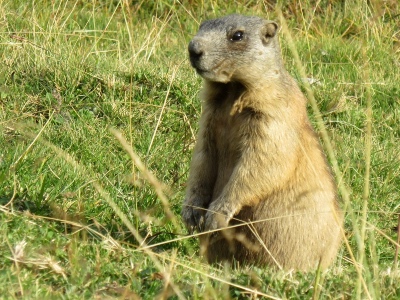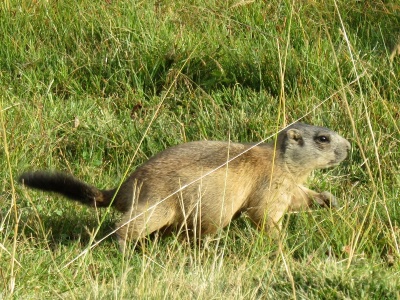Once upon a time in the Alps, the marmots were friends with the powerful kingdom of Fanes. They lived in peace, reigning over the mountains, valleys and meadows, until the queen of Fanes decided to marry. The new king, however, strove for more power and allied himself with the Eagles. As a pledge, he had to promise one of his children. When the queen gave birth to two beautiful princesses one day, she wanted to save her children and therefore exchanged one of them for a white marmot, which the eagles accepted as a pledge. The exchanged princess grew up in safety with the marmots. Her sister grew up in the kingdom and became a very skilled and feared warrior. The evil king, however, prevented her from marrying her great love, and betrayed their people to their enemies – sadly losing his daughter as well. Finally, as punishment, he turned to stone – and the queen and her daughter, who had grown up with the marmots, were left alone. To this day, it is said, the two of them go out on a lake some nights and wait for the resurrection of their kingdom.

This epic saga of the Fanes has been told for hundreds or maybe even thousands of years by the Ladin people of the Dolomites. Among the heroes of this story – despite their rather cuddly appearance – are the marmots. There’s more to these furry mountain dwellers than you might think at first glance: from funny names to clever communication and architectural skills.
1. Alpine marmots are vegetarians.
Marmots stick strictly to a vegetarian diet of grass, herbs and flowers that they find in the mountain pastures. And they eat a lot – adult marmots, which are about 50 centimetres long and weigh five to six kilograms, must take in one and a half kilograms of food each day! You can compare this to a human eating 15 to 20 kilos of grass (which would not be a recommendable diet). There’s a reason for this extreme eating schedule: in winter, marmots cuddle up in their underground burrows and hibernate – during this time they can’t eat at all and lose a third or even half of their weight. No wonder, they eat so much that up to two kilos of their weight is made up of fat!
2. Marmots have a big family.

Marmots live in groups of up to 20 animals – one big family started by the parents. They play and care for each other’s fur, but they also keep an eye out for each other and potential enemies. But playing and cuddling doesn’t mean everyone is on the same level: There is a superior male and a superior female who are in charge. What is more, their species has relatives all over the world: marmots, which all belong to the squirrel family, can be found in Canada, Alaska and Asia!
3. They are engineers.
Marmots are sometimes called the engineers of the Alps because they dig deep tunnels and burrows. Some of these tunnels, such as those used for hibernation, can be up to 7 metres under the ground! The marmots’ way of digging and their tunnels, as well as their nutrition, are very important for other animals and therefore for the entire ecosystem.
4. They communicate by whistling.
When hiking in the Alps, it’s the shrill whistles that let you know there are marmots around. But they don’t whistle for fun, or to greet you (sadly, unlike the Fanes legend), but to warn each other of danger. Experts believe that one whistle means immediate danger – such as an eagle swooping down from the sky – while a series of whistles warns of more distant enemies or threats, such as humans approaching their territory.
5. Subterranean Dwellers.
Marmots can reach an age of up to 15 years. But they don’t just spend it sunbathing and eating grass – it’s estimated that they live under the ground for almost 90% of their lives.
6. They are animals of the ice age.
Our modern marmots originated in the Ice Age – so they are used to cold conditions. That is why they live in cool burrows in the mountains. Climate change is making it harder for them because they cannot sweat like humans or pant like dogs, and if the mountains become too hot, they have nowhere to go.
7. Marmots, mice and cats

Where does the name marmot come from? One possibility, according to scientists, is the Latin “mus montanus” – which means mountain mouse! However, as mentioned above, they actually belong to the squirrel family. But hunters have even more creative names for these animals: a female marmot is called a “cat”, a male marmot is called a “bear” and the young are called ” apes”.
Would you have imagined what these cuddly animals are capable of? Although they may not behave exactly as in the Fanes legend, they are very peaceful and have many interesting characteristics ( as well as some pretty cool digging skills). Fortunately, their species is not in danger at the moment – as long as climate change doesn’t make the Alps too hot, they can enjoy eating herbs in the sun, digging tunnels, playing and whistling as much as they like.
References:
- https://de.wikipedia.org/wiki/Murmeltiere – Wikipedia, 05/05/2023
- https://www.geo.de/geolino/tierlexikon/2097-rtkl-tierlexikon-alpenmurmeltier – GEOlino, accessed 29/06/2023
- https://www.wwf.at/artenlexikon/das-alpenmurmeltier-der-ingenieur-der-berge/ – WWF Österreich, accessed 29/06/2023
- https://herz-fuer-tiere.de/wildlife/wildtier-lexikon/wildtierarten-mit-a/alpenmurmeltier – Ein Herz für Tiere, accessed 29/06/2023
- https://www.kindernetz.de/wissen/tierlexikon/steckbrief-murmeltier-alpenmurmeltier-100.html – Barbara Kiesewetter, SWR KINDERNETZ, 20/10/2020
- https://gruener-soelden.com/aktiv-outdoor/alle-lieben-murmeltiere/ – Alpengasthof Grüner, accessed 05/07/2023
- https://www.kronplatz.com/de/entdecken/dolasilla-sage – Tourismusverein Bruneck Kronplatz, accessed 05/07/2023
- https://en.wikipedia.org/wiki/Kingdom_of_Fanes – Wikipedia, accessed 05/07/2023

